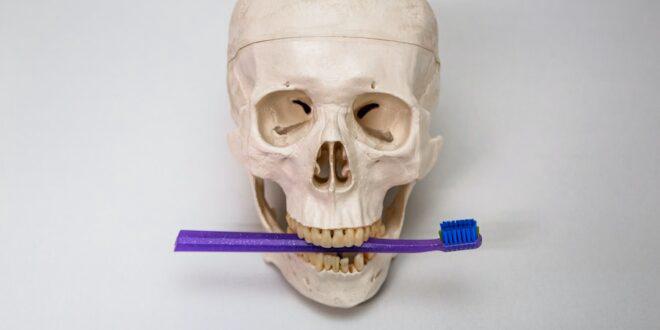How thick is the human skull? This is a common question since most people are impressed by how hard the human skull is.
You may have hit someone’s head and felt the impact, so you wondered just how much bone they have in their head.
The skull is a crucial human body part and must be thick enough to protect the brain. The brain is sensitive, and the slightest damage could harm the whole body, making the skull crucial. So, how much thickness does it need to protect the brain? Let’s find out;
How Thick Is The Human Skull?
The thickness of the skull depends on the gender and specific part of the skull. The front part in men is 7.8 mm thick, the side of the head is 9.6 mm thick, the back region is 10.1 mm thick, and the temporal area is 6 mm thick.
On the other hand, women have a somewhat different thickness profile, with the frontal region measuring 8.6 mm, the parietal region measuring 10.1 mm, the occipital area measuring 10 mm, and the temporal region measuring 6 mm.
Understanding The Importance Of The Human Skull
The human skull, also known as the cranium, is a testament to the intricacies of our physical design. While it may seem like a unit, it is actually comprised of 22 bones that each serve a crucial purpose.
These bones constitute the foundation of the skull, encompassing not only the brain’s protective framework but also the delicate architecture of our facial features.
One of the most critical roles of the skull is to protect the delicate and intricate organs that reside within the skull.
This protective duty includes protecting the brain, brainstem, and eyes from external injury, as nature’s fortification for these critical human intellect and sensory perception components.
The skull extends beyond its protective function by supporting the soft tissues that define our face and scalp.
These tissues include the muscles that control facial expressions, the sophisticated network of blood arteries that supply the brain, and the connective tissues that allow for basic processes like swallowing, breathing, and seeing.
The connection between the bony structure of the skull and these soft tissues demonstrates the remarkable equilibrium established in human anatomy. What’s incredibly impressive is that the task of skull creation begins at the very beginning of human life.
During the first eight weeks of pregnancy, the parts of the skull begin their complicated dance even before most people know their existence.
This is a time of rapid growth and development during which the skull blueprint and the initial phases of the nervous system begin to take shape.
The bones of the skull take on their characteristic shape as gestation advances, ultimately resulting in the intricate and distinctive framework that marks the human head.
In essence, the human skull is an evolutionary marvel, a collection of bones that serves to preserve the critical organ of the brain and facilitate the extensive range of functions that distinguish us as humans.
Its growth from infancy to maturity demonstrates the wonders of nature’s design, reminding us of the splendor and intricacy that comprise the human body. The skull, with its numerous bones and varied functions, exemplifies the beauty of life’s creations.
Human Skull Anatomy
The skull is an intricate structure that forms the basis of the head, holding some of the most critical organs and systems known to humankind. Let us take a detailed look at the skull anatomy.
The skull takes its proper place at the nexus of the spinal column, smoothly integrating with the neck and securing its crucial function in safeguarding the brain and brainstem.
These two parts, snuggled within the cranial cavity, form the center of the neurological system, directing the harmony of our body activities.
Nature’s mighty fortress, the hard bones of the skull, protects these sensitive tissues from damage and external threats.
The delicate architecture of the skull bones allows the passage of nasal sinuses, which are essential to our respiratory functions.
This multi-layered construction goes even further by protecting the eyes and the precise inner workings of the ears, allowing the vital senses of vision and hearing to function.
The neurocranium
This is a significant section of the skull that encases and protects the brain and takes center stage. This elaborate design comprises bone plates that are precisely linked together by sutures.
These sutures remain elastic and adaptable throughout infancy, allowing further brain expansion. Fontanelles, or soft junction points, gradually close during the initial phases of infancy, representing the extraordinary metamorphosis of the human skull.
Even into early adulthood, these sutures retain some flexibility, supporting the brain’s continuing expansion before solidifying.
At the pinnacle of the skull is a collection of bones that includes the frontal bone, parietal bone, temporal bone, and occipital bone. These staunch sentinels form the protective barrier covering the brain’s top and back.
They form a stable bone tunnel in the back, allowing the brainstem and spinal cord to pass through and join the spine.
In addition to its involvement in forehead creation, the frontal bone supports and protects the eyes, demonstrating the skull’s multifunctional prowess.
The viscerocranium
This is the frontal region that shapes the face. Within this region, there are 14 bones that play a role in defining our unique facial features.
These include conchae, nasal bones, maxilla bones, palatine bones, lacrimal bones, zygomatic bones, the mandible (lower jaw), and vomer. Together, they shape our appearance while acting as a shield for our sinuses and eyes.
The vital temporomandibular joint (TMJ) is positioned in the viscerocranium, linking the upper and lower jaw bones and permitting the delicate operations of chewing and eating.
The human skull is a wonder of nature’s engineering despite its complexity. It protects the brain and its intricate connections while providing structural support for the face and the vital senses of sight and hearing.
Its progression from the malleable fontanelles of childhood to the sturdy structure of adulthood represents the fantastic journey of human development. The skull, with its numerous bones and diverse purposes, is a tribute to nature’s elegance.
Common Head Injuries Related To The Skull
The skull is thick and tough, but it is vulnerable to damage like all parts of the human body. Damage to the skull is a risky situation to be in, and you need all the information you can get on the topic.
Head injuries, varying in severity and nature, pose a significant threat to the well-being of individuals across different age groups and backgrounds. These injuries can result from various causes and often require careful medical attention.
Let’s understand the types of head injuries and the diverse circumstances that can lead to their occurrence.
1. Concussion
A concussion is a type of traumatic brain injury (TBI), one of the most common head injuries. It happens when the brain is jarred or shaken violently, causing it to collide with the inner walls of the skull.
The impact might be minor or severe; interestingly, a concussion does not always require a direct hit to the head. A forceful blow elsewhere on the body can generate enough force to cause a concussion, emphasizing the brain’s fragility.
2. Contusion
A contusion occurs when the brain bears the force of an injury, resulting in a bruise. Contusions can cause bleeding and edema in the brain, presenting significant health hazards.
3. Intracranial Hemorrhage (ICH)
This type of head injury is bleeding beneath the skull in the brain, which causes a clot to form. The degree and location of ICH inside the brain might vary, and the implications can range from minor to severe, depending on the individual site.
4. Fracture of the skull
A cracked skull bone can sometimes directly influence the brain. The sharp bone pieces can pierce brain tissue, causing bleeding and other damage. The position and nature of the fracture determine the degree of the damage.
Common Causes Of Head and Skull Injuries
Head injuries can result from various sources, each with its circumstances. It can range from a direct hit to the head to sudden movements or twists of the upper body.
Car or motorcycle accidents falls, assault of kids, acts of aggression, sports-related injuries, cycling, football, basketball, baseball, and softball, and riding powered recreational vehicles are some of the triggers.
Head traumas cover many conditions, each with its characteristics and consequences. Understanding the many forms of head injuries and their causes is critical for avoiding and managing the dangers of these potentially life-changing events.
Individuals, caregivers, and communities must be keen on protecting against the catastrophic impact of head injuries, whether through heightened safety measures, protective gear, or early intervention.
Conclusion
You have a detailed response and more information on the human skull; if you were wondering, how thick is the human skull?
The skull is thick and hard to protect the brain and upper end of the spinal cord from physical damage.
Despite its toughness, the skull is vulnerable and could easily fracture or cause medical complications if hit hard enough.
You must take all necessary precautions to prevent getting hit in the head and see doctors for comprehensive tests in case of an accident.
 Being Human
Being Human



